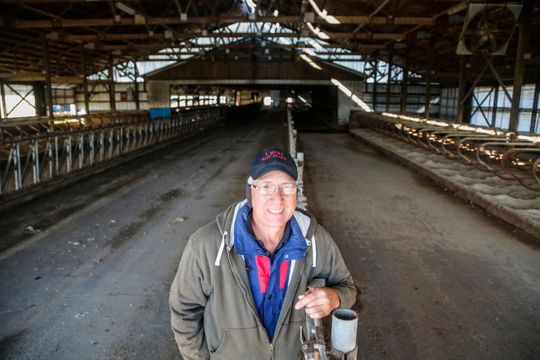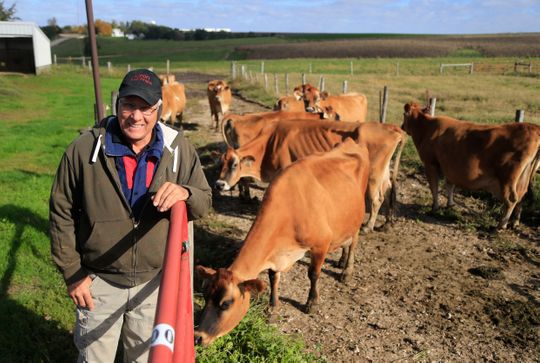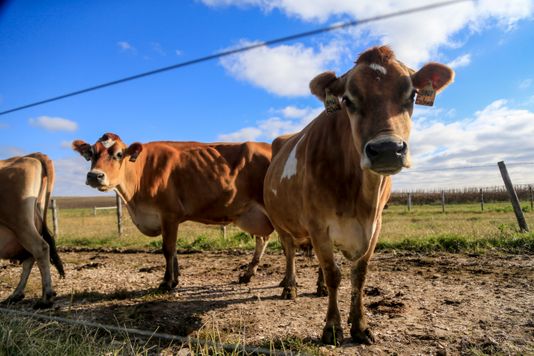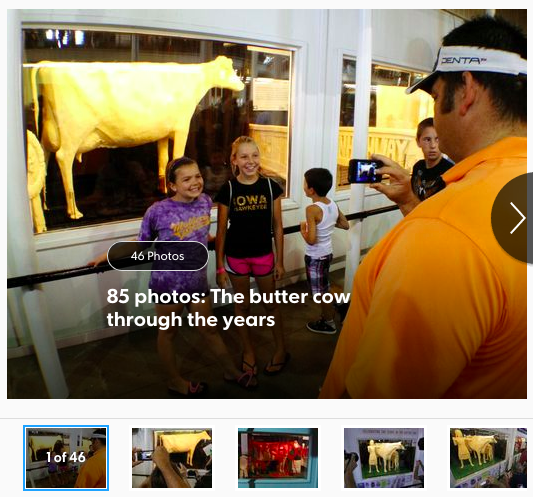USA Today: After years of catastrophic losses, dairy farms are increasingly closing their barn doors
by Donnelle Eller, Des Moines Register | Nov. 2, 2018
TOLEDO, Iowa – Eric Lyon stands in a massive dairy barn in eastern Iowa that until recently held about 320 cows.
The third-generation Iowa dairy farmer began selling off his family’s purebred Jersey herd a year ago, ending 95 years of milking.
He no longer could wait for relief from a punishing downturn that has hit America’s dairy industry.
“It was a hard decision,” Lyon said, especially for his 90-year-old father, Joe, whose late wife, Norma “Duffy” Lyon, made the family famous by sculpting the popular butter cow at the Iowa State Fair for close to 50 years.
Luckily, the Lyon family is financially able to shift to raising beef cattle after four years of fighting to keep “our heads above water,” he said.
Tumbling commodity prices and high production costs have hit several ag sectors over the past five years. But they have landed especially hard on dairy producers.
The industry has faced losses since hitting highs in 2014, forcing some dairy producers out through foreclosure. Others have thrown in the towel voluntarily, unwilling to wipe out what’s left of their assets, experts say.

Eric Lyon stands in his family’s empty dairy cow barn in Toledo, Iowa, on Monday, Oct. 15, 2018. (Photo: Zach Boyden-Holmes/The Register)
While a tough decision, Lyon’s family wanted to leave dairy production on their own terms, he said. “It would not be OK if we were auctioning off the farm in the yard,” said Lyon, 64.
Dairy producers are leaving the industry at about twice the average annual rate, experts say.
Wisconsin, the nation’s second-largest milk producer with 8,304 farms, had 634 fewer dairy farms in October than a year ago, data show. Over the past two years, the state has lost a total of 1,100 dairies. Iowa, the nation’s 10th-largest milk producer with 1,150 dairy farms, has lost about 80 this year.
“We’re seeing a significant loss of dairy farms,” said Larry Shover, president of the Iowa State Dairy Association board. “They don’t see a light at the end of the tunnel.”
Dairy farmers lose money every time they milk
Prices, about half what they were in 2014, have not yet hit all-time lows, experts say.
But it’s the longest amount of time that low prices – and negative profit margins – have persisted.
With the downturn expected to stretch into a fifth year, many farmers already have eaten through their financial cushion, said Mark Stephenson, director of dairy policy analysis at the University of Wisconsin-Madison.
And banks are re-evaluating whether they can continue to loan money to some dairies.
“It’s going to be difficult for some folks to talk with a banker about why they should have a good-sized operating loan,” Stephenson said.
The Midwest dairy industry typically loses about 3 to 5 percent of its farms naturally. The rate is now around 6 or 7 percent.
“It’s the highest clip that I ever remember Iowa losing farms,” said Larry Tranel, an Iowa State University Extension dairy specialist.
“A lot of farmers are tired of not being able to pay their bills – or are feeling this isn’t worth it for them anymore,” Tranel said. “Others, I’m sure, are being forced out.”
Dairy farmers lose money every time they open the barn door to milk, said Stan Deardeuff, regional coordinator at Iowa Mediation Service, a group that works to resolve financial differences between farmers and creditors.
Sadly, Stephenson said, loss of dairy farms should help pull the milk supply in line with demand. But, he added: “I’m not seeing it yet … but at some time, growth in production has to slow down.”
‘There are going to be casualties’
Farmers reaching out for help are more financially distressed now than a couple of years ago, said Alicia Harvie, an advocacy and farm services director at Farm Aid, the group singer Willie Nelson created three decades ago to support farmers.
“We’ve had a palpable uptick in calls from the Midwest and Northeast,” Harvie said. Most are dairy producers, followed by grain farmers. “They could be days or weeks from foreclosure.”
“It’s not through the fault of dairy farmers … it’s not poor management,” Harvie said. “It’s impossible to operate in a system that … pays people far less than it costs to raise their food.”
Deardeuff, who works more with struggling grain farmers than dairies, said farmers are eating through equity – the difference between the value in farmland, equipment and other assets and what’s owed on them – to restructure existing loans.
Growers have limited opportunities to do that, though, he said. “This year will be some people’s last crop year,” Deardeuff said. “There are going to be casualties.”
Tranel helps Iowa dairy producers assess where they’re at financially and discusses whether they can find areas to squeeze out more costs and add revenue.
Many times, producers have cut as many expenses as possible, he said. The analysis often leads to hard decisions.
“The profits just aren’t there for farmers,” he said. “And for young, beginning farmers, the numbers just don’t work out.
“I don’t remember a time when there was so little optimism about getting started in the industry,” Tranel said.

Eric Lyon stands next to a few remaining dairy cows on his Toledo farm on Monday, Oct. 15, 2018. (Photo: Zach Boyden-Holmes/The Register)
The catastrophe? We’re still producing too much milk
Stephenson believes many of the farmers leaving the dairy industry are near retirement, without a son or daughter to take over the operation.
“If you’re in your late 50s, early 60s, it may not make much sense to borrow against their equity to keep milking cows at a loss,” he said. “They may not have enough years to pay it back. … They’re chewing into their retirement.”
The industry is experiencing a global flood of milk that has depressed prices.
So far, U.S. production has continued to increase, even though a large number of dairy cows are being culled from herds, Stephenson said. Replacement heifers in the pipeline are still being added to dairies.
“The catastrophe is that we’re still producing more milk month after month after month,” Stephenson said, adding that the U.S. would need to see a significant increase in exports for dramatic improvement in prices. “I don’t see that on the horizon.”
The proposed United States-Mexico-Canada Agreement, which is expected to gain some dairy access in Canada, is unlikely to change that.
Regional leaders view the gains from the agreement “as too small and too far in the future to help dairy farmers,” the Chicago Federal Reserve said recently.
Leaving dairy’s long hours, losses is ‘like getting out of jail’
Tranel said farmers getting out of the business find their cows worth about half what they bought them for. “It’s a Catch-22,” he said. “They can’t afford to sell – and they can’t afford not to.”
Few places in agriculture offer room for profits, Tranel said. Farmers raising corn and soybeans, pork and beef have struggled to break even in recent years as well.
Nationally, U.S. farm income is expected to be about half what growers earned in 2013, when farmers set record highs. In recent years, slightly more than half of households have had negative farm income each year.
Stephenson said midsized farms were hit hard in the downturn: Unlike small dairies, owners are unable to handle the work by themselves and face the added cost of labor, which often is difficult to find. And they lack the efficiencies that big operations have.
Like other ag sectors, dairy operations are becoming huge, squeezing out small and midsized producers, Lyon said. At this point, though, “the hurt is across the board.”
Lyon, who farms with his cousin and father, is unsure whether the Red Angus cattle herd he’s building will be more profitable for his family. But the prices are more stable, he said.
Still, leaving the industry’s mounting losses, and long hours of work, is a relief, Lyon said.
“No offense to cowboys,” he said, but raising cattle will be easy compared to producing milk. “It’s like getting out of jail.”

